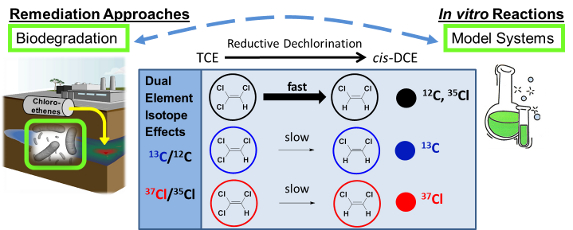Dehalogenation Mechanisms

Dehalogenation Mechanisms from 37Cl/35Cl and 13C/12C Isotope Analysis
As a result of their widespread use as industrial solvents, chlorinated ethenes are among the most frequently detected groundwater contaminants. Biodegradation of these compounds under reducing conditions often leads to the accumulation of even more toxic degradation products such as cis-dichloroethene (cisDCE) and vinyl chloride (VC) from tetrachloroethene (PCE) or trichloroethene (TCE). Understanding the degradation pathways and the underlying reaction mechanisms is therefore of great relevance for contaminated site remediation and water management. While mechanistic insight has been obtained in chemical model reactions, methods are needed which prove that the same mechanism is indeed at work in natural biodegradation. We aim to bridge this gap with isotope measurements of the elements 37Cl/35Cl and 13C/12C.
Projects:
- To advance the dual (C, Cl) compound specific isotope analysis as a powerful tool to differentiate microbial degradation pathways (reductive vs. oxidative) of chlorohydrocarbons
- To investigate the reaction mechanisms of chlorinated ethylenes with different chemical model systems
Publications:
- B. Heckel, M. Elsner, Exploring Mechanisms of Biotic Chlorinated Alkane Reduction: Evidence of Nucleophilic Substitution (SN2) with Vitamin B12, Environ. Sci. Technol. 56 (2022), DOI: 10.1021/acs.est.1c06066
- C. Lihl, L.M. Douglas, S. Franke, A. Pérez-de-Mora, A.H. Meyer, M. Daubmeier, E.A. Edwards, I. Nijenhuis, B. Sherwood Lollar, M. Elsner, Mechanistic dichotomy in bacterial trichloroethene dechlorination revealed by carbon and chlorine isotope effects, Environ. Sci. Technol. 53 (2019) pp. 4245−4254, doi:10.1021/acs.est.8b06643
- B. Heckel, E. Phillips, E. Edwards, B. Sherwood Lollar, M. Elsner, M.M. Manefield, M. Lee, Reductive dehalogenation of trichloromethane by two different Dehalobacter restrictus strains reveal opposing dual element isotope effects, Environ. Sci. Technol. 53 (2019) pp. 2332−2343 doi: 10.1021/acs.est.8b03717
- B. Heckel, K. McNeill, M. Elsner, Chlorinated Ethene Reactivity with Vitamin B12 Is Governed by Cobalamin Chloroethylcarbanions as Crossroads of Competing Pathways, ACS Catalysis 8 (2018) pp. 3054−3066, DOI: 10.1021/acscatal.7b02945
- B. Heckel, S. Cretnik, S. Kliegman, O. Shouakar-Stash, K. McNeill, M. Elsner, Reductive Outer-Sphere Single Electron Transfer Is an Exception Rather than the Rule in Natural and Engineered Chlorinated Ethene Dehalogenation, Environ. Sci. Technol. 51 (2017), pp. 9663−9673, http://dx.doi.org/10.1021/acs.est.7b01447
- B. Heckel, D. Rodríguez-Fernández, C. Torrentó, A. Meyer, J. Palau, C. Domènech, M. Rosell, A. Soler, D. Hunkeler M. Elsner, Compound-Specific Chlorine Isotope Analysis of Tetrachloromethane and Trichloromethane by Gas Chromatography-Isotope Ratio Mass Spectrometry vs Gas Chromatography-Quadrupole Mass Spectrometry: Method Development and Evaluation of Precision and Trueness, Analytical Chemistry, 89 (2017), pp 3411–3420, http://dx.doi.org/10.1021/acs.analchem.6b04129
- Renpenning J., Keller S., Cretnik S., Shouakar-Stash O., Elsner M., Schubert T., Nijenhuis I. (2014): Combined C and Cl isotope effects indicate differences between corrinoids and enzyme (Sulfurospirillum multivorans PceA) in reductive dehalogenation of tetrachloroethene, but not trichloroethene. Environmental Science & Technology, 48 (20): 11837-11845.
- Cretnik S., Bernstein A., Shouakar-Stash O., Löffler F., Elsner M. (2014): Chlorine isotope effects from isotope ratio mass spectrometry suggest intramolecular C-Cl bond competition in trichloroethene (TCE) reductive dehalogenation. Molecules, 19 (5): 6450-6473.
- Cretnik S., Thoreson K. A., Bernstein A., Ebert K., Buchner D., Laskov C., Haserlein S., Shoukar-Stash O., Kliegman S., McNeill K., Elsner M. (2013): Reductive dechlorination of TCE by chemical model systems in comparison to dehalogenating bacteria: Insights from dual element isotope analysis (13C/12C, 37Cl/35Cl). Environmental Science & Technology, 47 (13): 6855-6863.
- Audí-Miró C., Cretnik S., Otero N., Palau J., Shouakar-Stash O., Soler A., Elsner M. (2013): Cl and C isotope analysis to assess the effectiveness of chlorinated ethene degradation by zero-valent iron: Evidence from dual element and product isotope values; Applied Geochemistry, 32: 175-183.
- Bernstein A., Shouakar-Stash O., Ebert K., Laskov C., Hunkeler D., Jeannottat S., Sakaguchi-Söder K., Laaks J., Jochmann M. A., Cretnik S., Jager J., Haderlein S. B., Schmidt T. C., Aravena R., Elsner M. (2011): Compound-specific chlorine isotope analysis: a comparison of gas chromatography/isotope ratio mass spectrometry and gas chromatography/quadrupole mass spectrometry methods in an interlaboratory study. Analytical Chemistry, 83 (20): 7624-7634.
- Hunkeler D., VanBreukelen B., Elsner M. (2009): Modeling Chlorine Isotope Trends during Sequential Transformation of Chlorinated Ethenes, Environmental Science & Technology, 43: 6750-6756.
- Elsner M., Hunkeler D. (2008): Evaluating Chlorine Isotope Effects from Isotope Ratios and Mass Spectra of Polychlorinated Molecules. Analytical Chemistry, 80: 4731-4740.